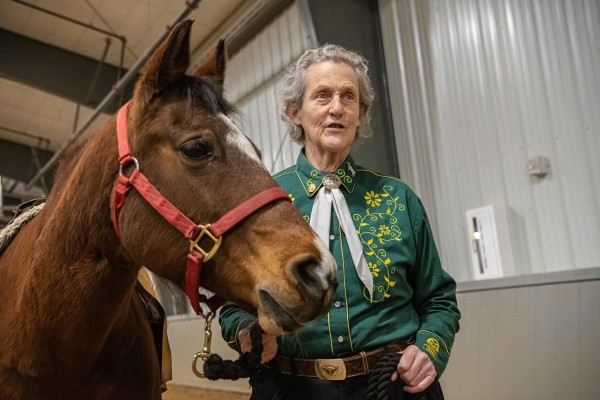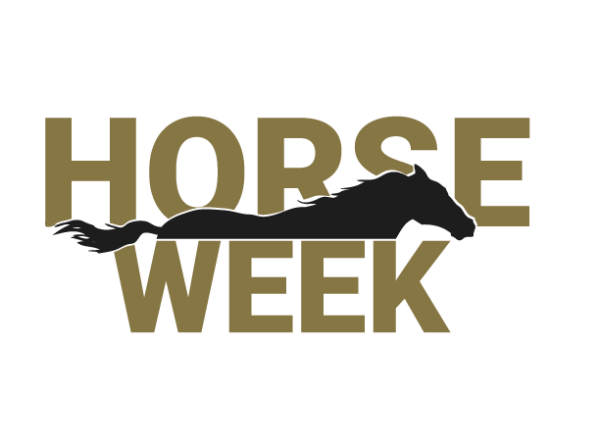Home > Horse World > Researching how horses help humans
Researching how horses help humans
- September 21, 2021
- ⎯ Dee McVicker
For the decades, horses have helped people recover from physical, mental and emotional challenges. Hippotherapy—the use of equine movement in physical, occupational and speech language therapy—has grown from a limited and specialized form of treatment to a widely accepted and sought-after option.
Yet the benefits of equine-assisted therapy haven’t been extensively studied or even reliably quantified. In fact, the scientific reviews that have been done on the topic consistently point to a lack of research into how and why horse movement may be beneficial.
Researchers at the Temple Grandin Equine Center at Colorado State University in Fort Collins hope to change that. “Our main goal is to advance the scientific rigor behind the anecdotal evidence,” says Caitlin Peters, PhD, senior researcher at the center, where randomized, controlled studies are taking up the challenge of producing good scientific data supporting the benefits of horse movement for all, starting with youth with autism.
Why data matters
Hippotherapy is well-known—anecdotally, at least—to increase coordination, muscle tone, and the well-being of people with cerebral palsy and other physical disabilities. Its use for individuals with autism is a more recent development but is increasingly seen as a promising therapy for a growing population: It is estimated at 1 in 54 children have some degree of autism.
“Individuals with autism are the number one population served in our centers right now,” says Kaye Marks, director of marketing and communications for Professional Association of Therapeutic Horsemanship (PATH) International, an association that has more than 800 member centers serving almost 70,000 children and adults through equine-assisted programs.
As part of their initial work, researchers at the Temple Grandin Equine Center have compared two groups of youth with autism, in one participants received therapy with horses in an arena and in the other participants received the same therapy in the clinic room but without horses. Although it’s still early in the process, they are already putting meaningful scientific data behind the anecdotal stories.
“There’s a point where you start to see a pattern with some of the anecdotes,” says the center’s namesake Temple Grandin, Colorado State University Department of Animal Science professor. “We want evidence-based research that it works… I like real results that are not abstract,” adds the world-famous animal behaviorist and autism spokesperson who learned firsthand the therapeutic benefits of horses as a teen with autism.
The researchers’ findings will be used to establish baseline practices and predictive outcomes for occupational, physical and speech language therapists. Those findings could also be of interest to insurance companies, which, lacking the quantitative and qualitative evidence proving the effective use of equine movement in occupational therapy for people with autism, have been slow to pay for it in the past.
“If an insurance company is denying treatment to a patient with cerebral palsy or multiple sclerosis, we can whip out a bunch of studies and say, ‘Here’s the body of evidence that says that this treatment tool will work for this particular patient population.’ We don’t have as much evidence at this point in autism. The research they’re doing can be hugely beneficial to getting more insurance companies to approve the use of equine movement for treatment,” says Mary Helene Chaplin, PT, HPCS, a practicing physical therapist as well as co-chair of the American Hippotherapy Association (AHA), which provides education and certification standards for professional therapists.
What only horses can do
Horses are big, expensive and require expertise to handle. Wouldn’t it be easier to use dogs for the same therapy? Peters explains that it’s the movement and rideability of horses that makes them perfect for the job. “People with autism are often too over-aroused, where they’re hyper or excited or too irritable to actively engage in what’s going on,” she says. “Or they’re under-aroused, where they’re tired and so disengaged that they’re not able to engage in what’s going on. Horse movement helps us regulate that.”

Jumping on a trampoline or swinging on a swing can help a person with autism reach that optimal arousal state, too, says Peters, “but it’s hard to do anything other than that thing. If a child is on a trampoline, they are on a trampoline and it’s hard to do anything else but jump on a trampoline, versus, if they are on a horse for 60 minutes, they are getting that level of stimulation needed [while accomplishing other therapy goals]. The fact that you can do those two things simultaneously is unique and quite different from how you would incorporate a dog into therapy.”
Also unique to the horse is that its movement is highly adaptable to whatever a particular patient needs in the moment. “A horse takes on average a hundred steps a minute, so every step they take is impacting that patient on the horse. I can’t move a therapy ball a hundred times in a minute. And I can manipulate the [horse’s] movement in terms of their stride length and impulsion and speed. I can change so many things as a therapist if the horse is well trained for it,” explains Chaplin, who helps educate therapists as one of her roles with AHA.
“Everything we do has got to be based on some sort of evidence-based treatment. We have to have a body of knowledge to come up with our treatment plan. It has to have some evidence to support it,” Chaplin adds.
The early scientific findings
One fact that is already supported by data is that grooming, riding, and interacting with horses in adaptive riding programs-meaning riding adapted to the unique needs of a population or disability group -offers beneficial outcomes. Adaptive riding studies have shown improvement in a rider’s heartrate variability, salivary cortisol levels and galvanic skin or electrodermal response measured in sweat on a wristband, for example – all indicators of calmness and a gauge of the rider’s parasympathetic and sympathetic nervous systems.
“They’ve demonstrated that adaptive riding can decrease irritability and increase social communication and social motivation. If they can do this with just horsemanship skills, imagine how then we can use that in our treatment to increase outcomes in occupational therapy,” Peters says.
That calming effect on individuals with autism, and the resulting alert state optimal to socialization or engagement in learning as part of an occupational therapy plan is what researchers at the Temple Grandin Equine Center set out to measure in their first pilot studies.
For these studies, eight participants in two groups between the ages of 6 and 13 completed ten weeks of occupational therapy incorporating horses in the arena and ten weeks of the exact same occupational therapy without horse assistance in a clinical room. Researchers closely followed a four-step framework recognized by the National Institutes of Health for how interventions are best developed for youth with autism, followed by scientific standards for measuring behavior and social outcomes.
The researchers incorporated weekly parent reporting on the frequency and severity of behaviors such as difficulty tending to tasks as a measure of hyperactivity or stomping feet or screaming as a measure of irritability. Parents and therapists also reported on social engagement of participants using the widely accepted Social Responsiveness Scale (SRS), which is used in diagnosing autism because it keys into the areas that are often impaired in youth with autism. Parents tracked their child’s progress against individualized goals, such as transitioning from one activity to the next or being introduced to new acquaintances and motivations.
Initial findings based on parent reporting indicated that adding horse movement to occupational therapy decreased participants irritability and hyperactivity and increased their ability to communicate in social situations as well as their motivation to engage in social situations.
“We found that youth in the horse group had increased goal attainment,” says Peters. “They were meeting their goals faster and meeting more of their goals than youth who participated in occupational therapy without a horse. We were excited about that because often with equine assisted services, it’s hard to tease out what is being provided by the professional and the unique contribution of the horse incorporated into the therapy.”
Effect size, or the statistical size of the effect indicating how much of a difference the intervention had on outcomes, were small to medium in the center’s phase two study of 24 participants over ten weeks, depending on outcome measures. “For instance, we saw a seven-point decrease in irritability and hyperactivity and a several point increase in social engagement,” Peters says.
The significance of this research is not so much the findings–anyone who has spent time with horses knows they can have a transformational effect on someone’s mindset and outlook on life. Rather, it’s that the researchers at the center are doing what so many others haven’t been able to do: isolate the therapy being provided from the unique contribution of the horse incorporated into that therapy. “For this population and for that service—occupational therapy—this could very well be the first randomized control research for youth with autism,” Peters says.
It will be another few months to a year before the findings are published and reviewed by the scientific community, but researchers at the center are already planning the next study. That study will likely include over a hundred participants and involve salvia testing as an indication of stress and observation tools for coding and comparing social behaviors of separate control groups in the arena and in the clinic. Researchers expect these research studies to eventually help individuals suffering from dementia, post-traumatic stress disorders and other disabilities.
Through the years, horses have enriched the lives of tens of thousands of individuals with various physical, emotional and cognitive challenges. And while inspiring tales of children with autism speaking their first words while riding are common, soon the scientific evidence of the benefits of equine-assisted therapies may soon follow, thanks to the work of researchers at the Temple Grandin Research Center.

Scientist, professor and animal behaviorist Temple Grandin began showing signs of autism in 1949 at the age of 2. Horses played a major role in her development from an autistic youngster to world-famous animal behaviorist, autism spokesperson and professor at Colorado State University’s Department of Animal Sciences.
As a teenager, Temple developed her deep understanding of horses during a visit to her aunt’s guest ranch one summer. She often speaks of the bullying she endured in school and how her interest in horses helped her make friends. Later, her affinity for horses and animals in general enabled her to build a successful career in the livestock industry. More than half the cattle that go to meat processing plants in the United States today go through a “squeeze chute” that she designed to relieve stress and provide more humane control of the animals.
Temple today is considered an expert in two fields: animal welfare and autism. She is the author of several books, including the popular “Animals in Translation: Using the Mysteries of Autism to Decode Animal Behavior.” She was the subject of the Emmy- and Golden Globe-winning semi-biographical film “Temple Grandin” starring Claire Danes. Temple was inducted into the National Women’s Hall of Fame in 2017 and has been one of Time magazine’s “100 Most Influential People.”
This article and Horse Week feature video are brought to you by Absorbine.

Horse Week: October 3 – 9
Learn how the therapy horses at the Temple Grandin Equine Center are changing their riders’ lives in Absorbine’s Horse Week feature video, The Wings We Lack on Monday, October 4 at 8 p.m. EST. Check out more must-see equine content October 3-9, 2021 during Horse Week brought to you by Boehringer Ingelheim Equine Health at horseweek.tv.
WATCH the trailer for The Wings We Lack below.






